Planning a visit to the Accademia Gallery in Venice Italy? The Galleria dell’Accademia is Venice’s most important museum and one of the best museums in Italy. In this guide, I give you an overview of the museum and identify 15 masterpieces you can’t miss.
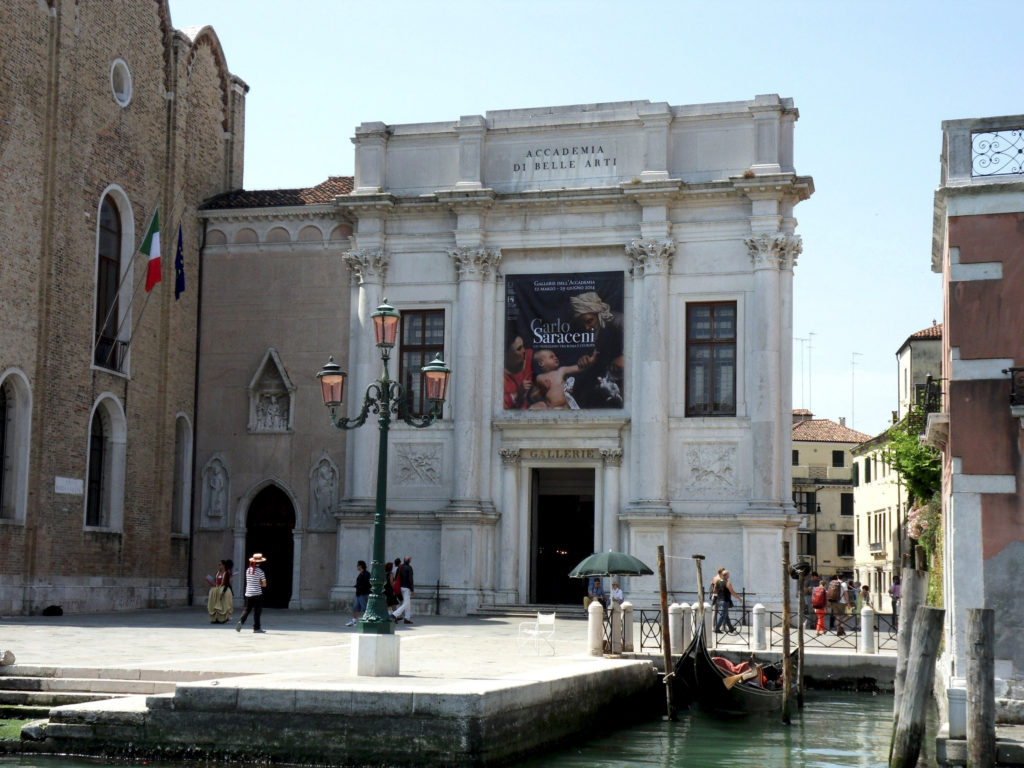
The Accademia houses the world’s best collection of pre-19th century Venetian painting. The museum traces the evolution of Venetian art from the Middle Ages to the 18th century.
The gallery has paintings by luminaries such as Veronese, Titian, Tintoretto, Tiepolo, Bellini, Canaletto, and Giorgione. Its prize possession is the world’s most famous drawing, Leonardo da Vinci’s Vitruvian Man, although it isn’t often on display.
The Accademia is almost always empty, even during high season. I know, I’ve been in July.
Given the museum’s vaunted collection, it’s rather shocking. Perhaps the collection is difficult viewing if you’re not an art lover. Or, people associate Venice with canals and gondola rides and not art.
In any event, the Accademia is a wonderful place to see great art without the crowds of Italy’s better known museums like the Uffizi Gallery or the Vatican Museums.
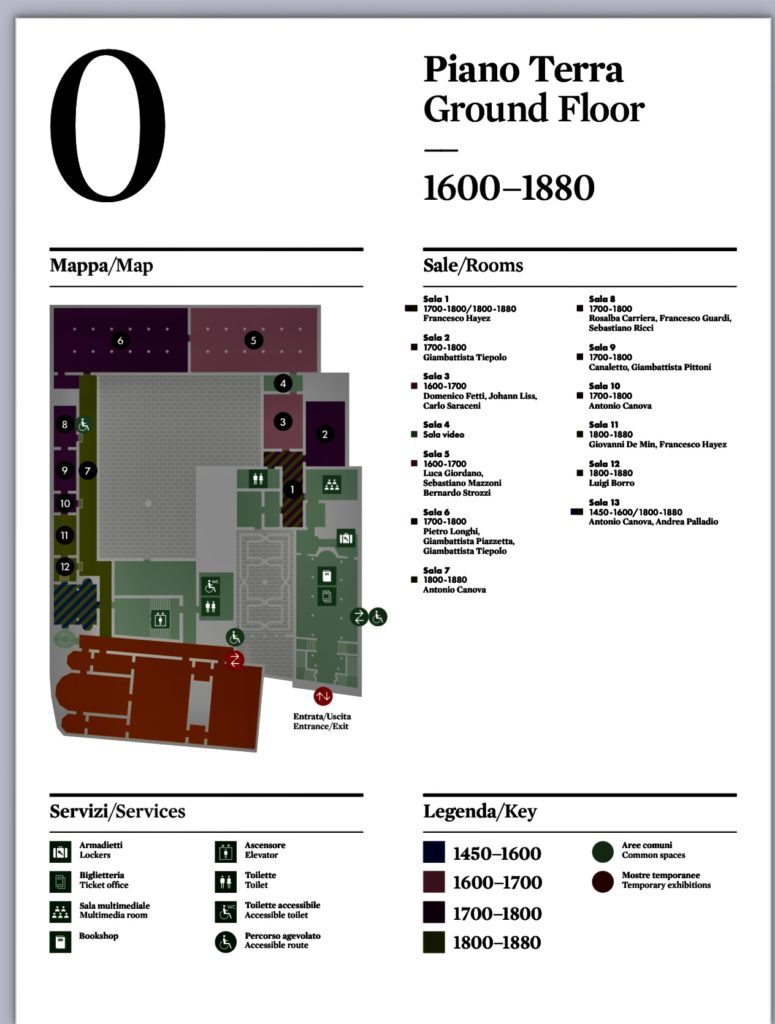
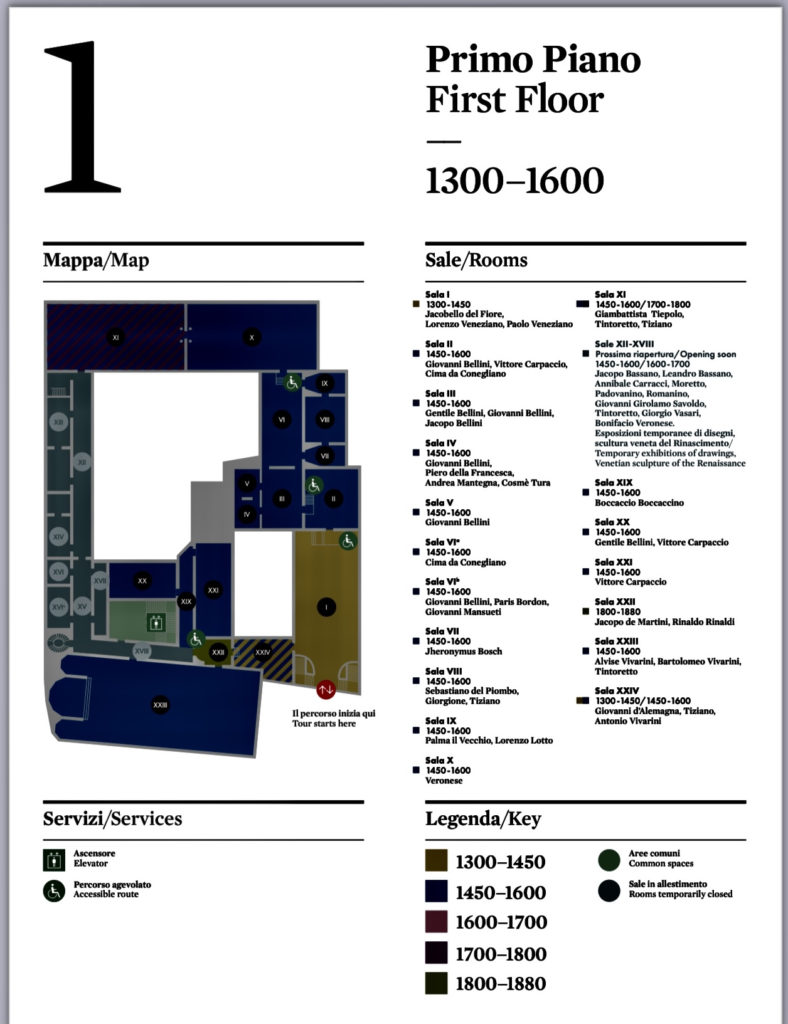
Overview and Architecture of the Accademia
Founded in 1750, the Accademia occupies three buildings. They were originally a church, monastery, and scuola. In Venice, a scuola was a social club of wealthy citizens dedicated to charitable works.
The Accademia was built by a bevy of great architects, including famed Italian Renaissance architect Andrea Palladio. The museum itself is a work of art.
You head in the front door and walk up the stairs to the first floor. You’re in a magnificent space that was once the grand meeting room of the scuola. Your eyes are immediately drawn to the extraordinary gilded ceiling.
Altogether, the Accademia has 24 rooms. They are arranged in chronological order around two courtyards. The largest courtyard was designed by Palladio.
In 2016, seven new rooms were inaugurated in a wing on the ground floor planned by Palladio. In this wing, you’ll find works by 18th and 19th century Venetian artists, including two famous students of the Accademia, Antonio Canova and Francesco Hayez.
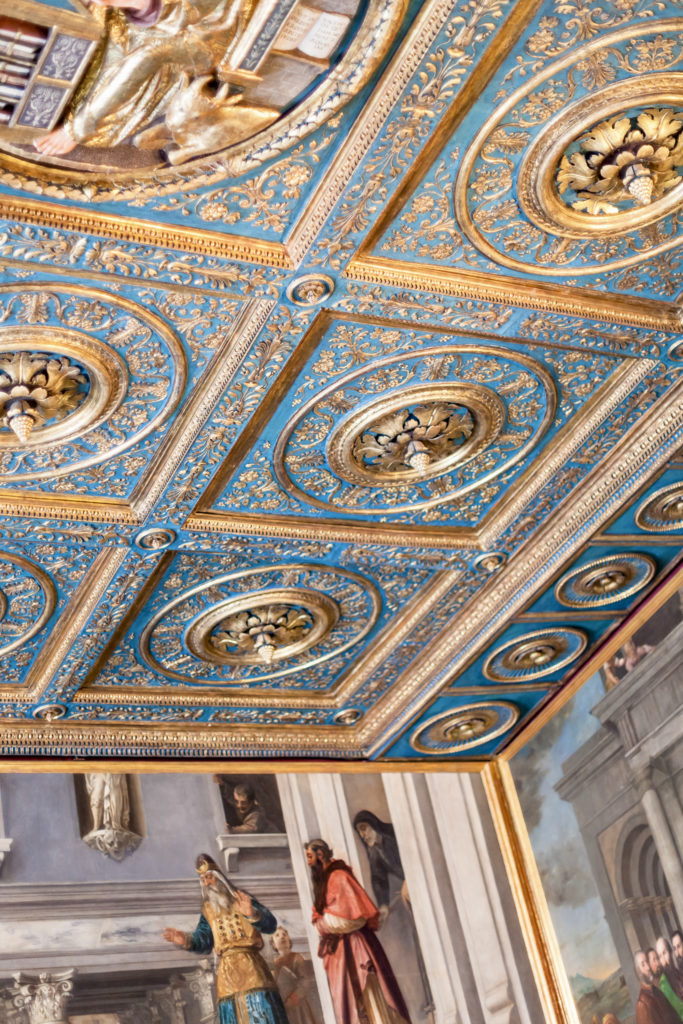
What Is The Venetian Renaissance?
When people talk about the Renaissance, most people think of the Renaissance center of Florence. That’s where the Renaissance began and then spread throughout Tuscany, Rome, and central Italy.
But Venice had its own distinct Renaissance. The Venetian School developed a bit later.
It began in the late 15th century and lasted until around 1580. Venice’s Accademia is the equivalent of Florence’s Uffizi Gallery in terms of housing great Renaissance works.
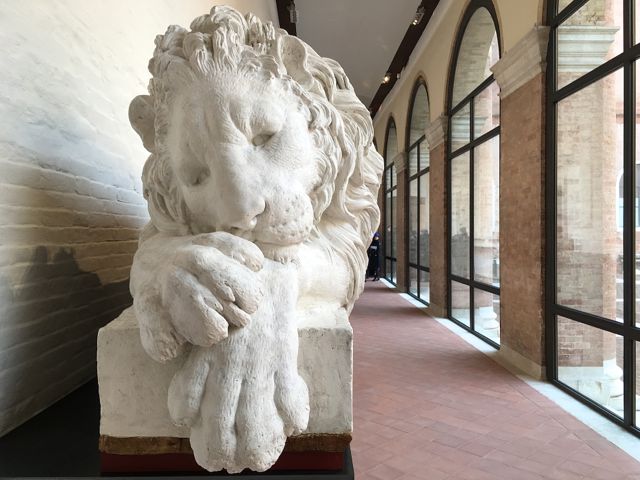
The painters of the Venetian Renaissance sought to mix classical painting with new forms and techniques. They used rich luminous colors and focused on lighting effects, embellishment, and sensual subject matter. They pioneered innovative and asymmetrical compositions.
Their approach captured the hedonism of the time, when Venice was effectively the Las Vegas of Italy. Venetian society relished in its new found wealth.
READ: Nutshell History of Venice
The most famous painters of the Venetian Renaissance were Giovani Bellini, Giorgione, Carpaccio, Titian, Veronese, and Tintoretto. Bellini and Carpaccio were active in the 15th century. Titian, Tintoretto, and Veronese were 16th century painters.
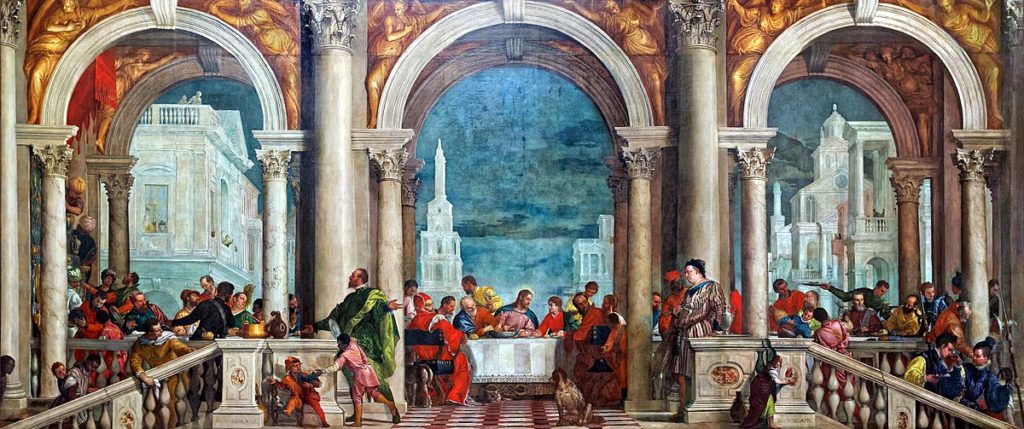
What To See At Venice’s Accademia Gallery
Here are 15 masterpieces you can’t miss at the Galleria dell’Accademia in Venezia.
1. Veronese, Feast in the House of Levi
Veronese’s The Feast in the House of Levi is a hugely famous painting from the Italian Renaissance. It’s probably the most spectacular painting in the Accademia, in both quality and quantity. Housed in Room 10, the painting is massive, 43 feet wide.
Veronese’s subject was the last supper, the final meal among Jesus and his apostles before Jesus was betrayed by Judas.
READ: Last Supper Paintings of the Renaissance
The painting is famous for its monumental architecture, incredible detail, and utter chaos. The depiction is set in a massive triple arched loggia.
Veronese deemphasized the actual biblical meal in favor of hedonistic images. He painted an assortment of drunken characters, jesters, and other revelers. It’s more of a fantasy version of a patrician dinner party than a true last supper painting.
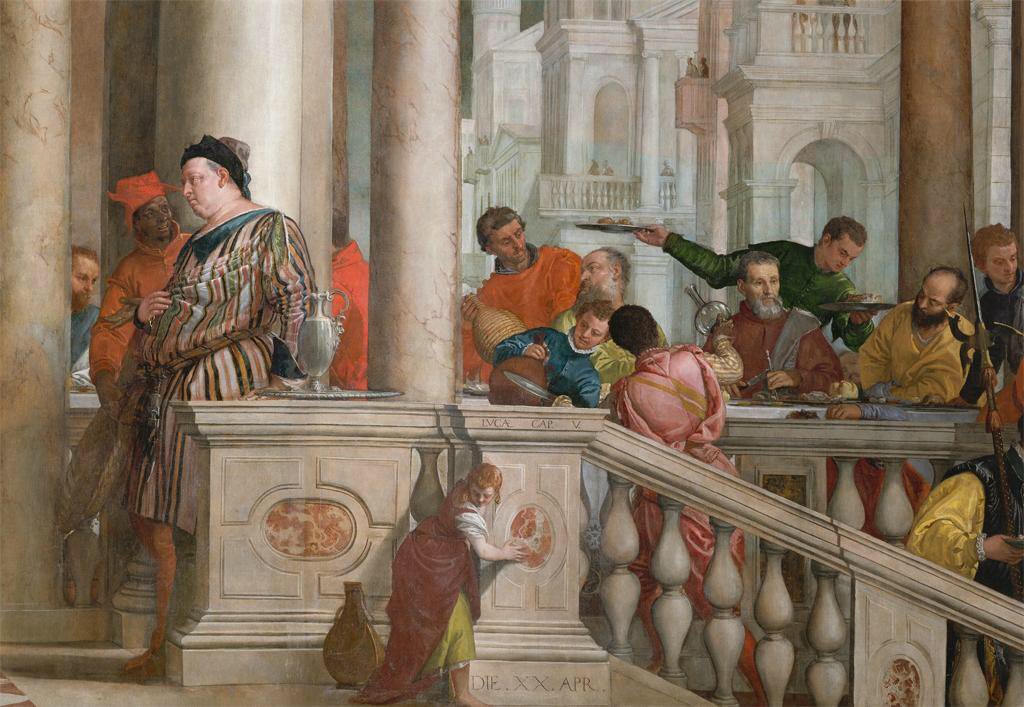
Christ is in the center, flanked by Saint Peter and Saint John. Judas sits across from him in red, looking decidedly fidgety and nervous. A dog and cat (the sign of the devil) sit at their feet.
Word got out about the racy and indecorous nature of Veronese’s last supper. The Inquisition censured Veronese for making a mockery of the holy meal. Religious images were supposed to have a certain propriety, after all.
Veronese was summoned to testify before the Inquisition. He refused to change any of the offensive details, citing artistic license. Veronese satisfied the Inquisition by simply changing the title of the painting.
One interesting fact is that the figure standing at the right in the second arch is an image of the Roman Emperor Vitellius. He was known as a notorious gluten.
READ: History of the Roman Emperors
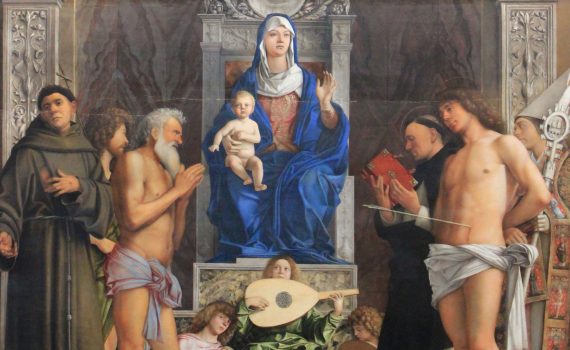
2. Bellini, St. Job Altarpiece
Bellini was the first great Venetian painter. His St. Job Altarpiece is generally considered to mark the first Renaissance moment in Venice.
The painting is a beautiful symmetrical arrangement of the Virgin Mary and the Christ child. Wingless angels play musical instruments. You see various saints — St. Francis of Assisi, St. John the Baptist, St. Job, St. Sebastian, St. Dominic, and St. Louis of Toulouse.
The real focus of the artist was to reproduce a mystical effect with the mosaics in the apse. It’s a call out to the mosaics of one Venice’s most important monuments, St. Mark’s Basilica.
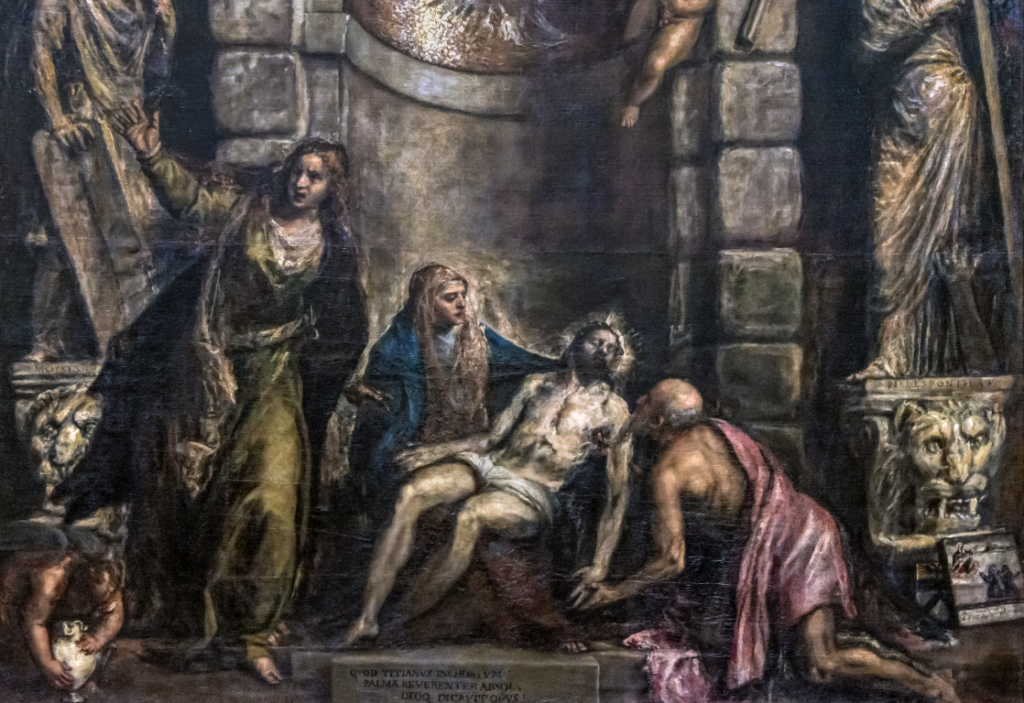
3. Titian, Pieta
Titian is widely considered the most important painter of the 16th century Venetian school. This beautiful Pieta was Titian’s last painting. Titian designed this dramatic painting to grace his own burial site in the Church of the Frari.
The Pieta is a work of tragic pathos. Mary holds her dead son for the last time, wearing an expression of deep lamentation.
On the right, Titian portrays himself as Saint Jerome reaching out to the body of Christ. We know it’s St. Jerome because of the lion next to him. On the left is St. Helena, Emperor Constantine’s mother.
Titian’s brush strokes are very free and impressionistic. This blurrier technique was either a natural evolution of his painting style. Or, as some assert, due to the fact that Titan was going blind.
In the course of the plague of 1576, both Titian and his son Orazio died. The canvas was left in his studio. It was eventually acquired and completed by Titian’s pupil Jacopo Palma il Giovane.
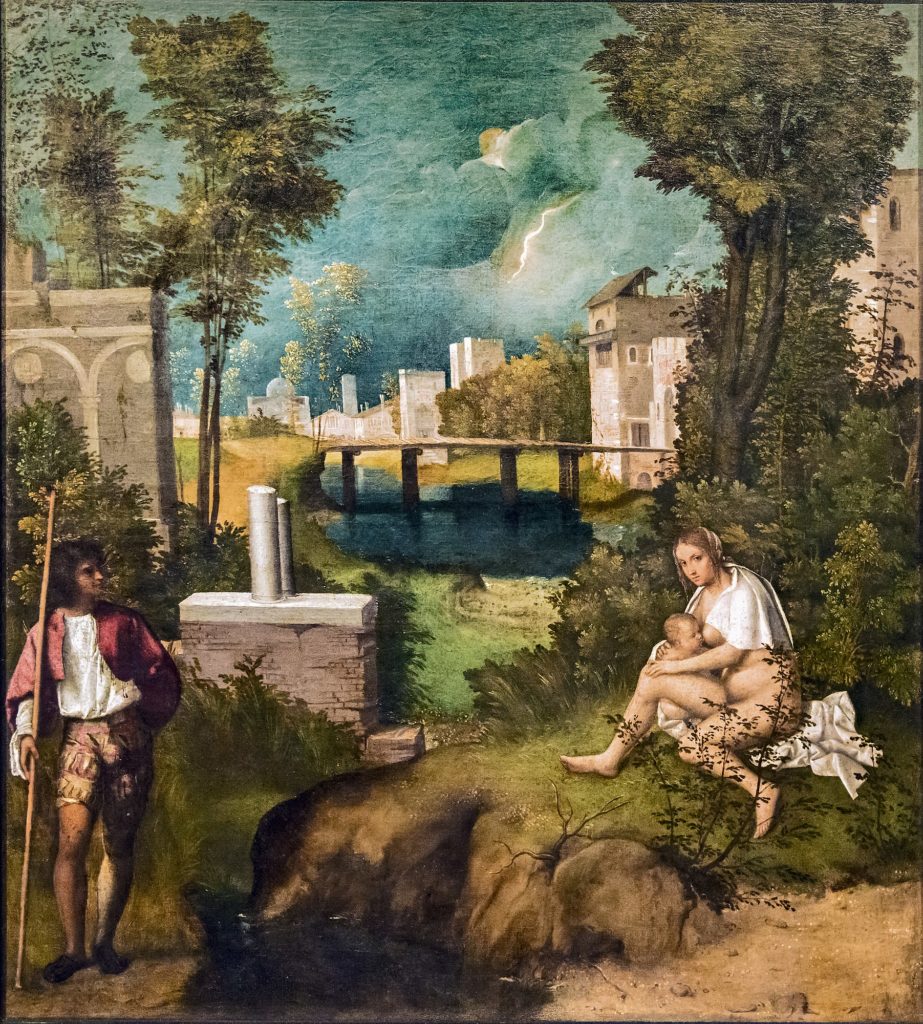
4. Giorgioni, The Tempest
Giorgione’s The Tempest is one of the most famous and controversial paintings in art history. Giorgione himself was an enigmatic figure. Giorgione had a short 15 year career, dying prematurely at just 37.
When he unveiled The Tempest, people were stumped. They couldn’t identify the novel subject matter of the painting. It was first identified simply as a woman and a solider.
Some art historians consider The Tempest to be the first landscape in the history of Western painting. The setting is the lush countryside engulfed in a lightening storm. A nearly naked women looks out at the viewer, as if questioning your intrusion.
Others suggest Giorgione intentionally created the first painting with no overt religious or moral subject. Instead, it was just a fantasy or capriccio (caprice). Still others suggest that it’s Giorgione’s interpretation of the rest on the flight into Egypt from the Bible.
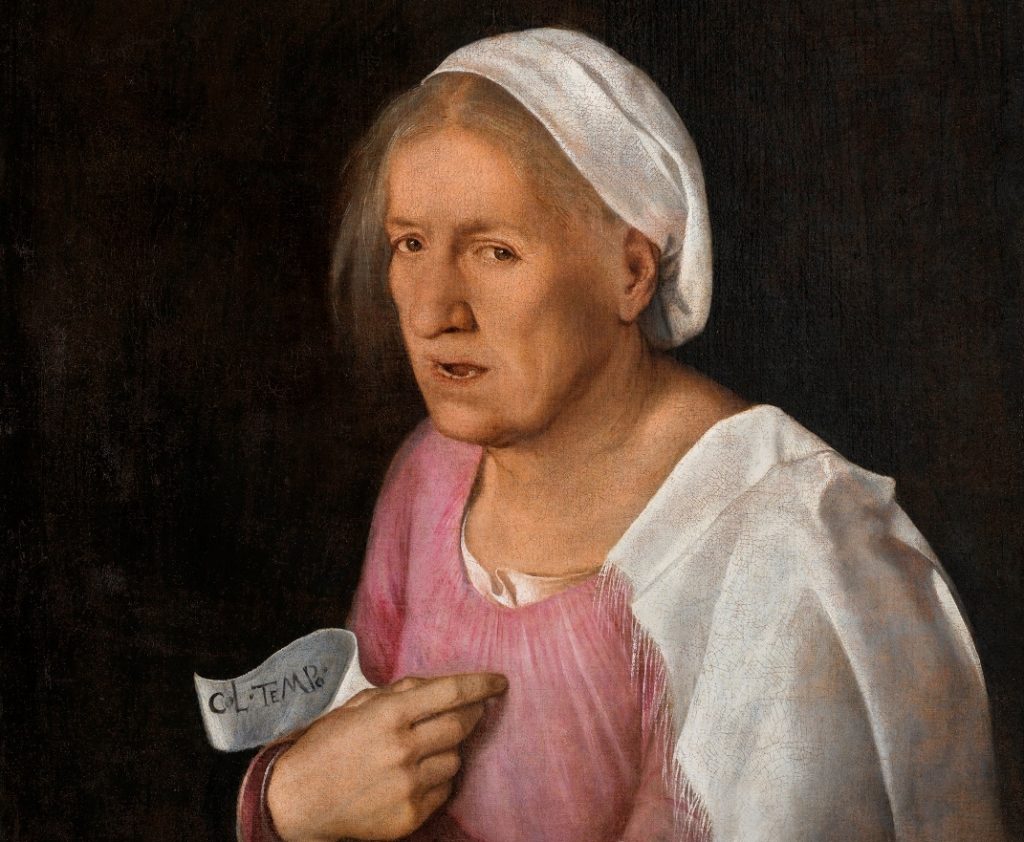
5. Giorgione, La Vecchia
This Giorgione painting is called La Vecchia, which translates to the old lady. At first glance, you might think it’s a portrait. But, because of the way she is dressed, you can tell she’s not rich enough to commission her own portrait.
So, the painting is something else disguised as a portrait. It has a completely black background and a photorealistic rendering. These were highly unusual techniques in the Renaissance. But they were later adopted by Caravaggio during the Baroque era in the 17th century.
The figure is an allegory, painted with Giorgione’s supernatural painting skills. With her right hand, the woman points to herself holding a scroll. The message is that time will claim all of us.
6. Leonardo da Vinci, Vitruvian Man
The Vitruvian Man is the most famous drawing on planet earth. The drawing was created when Leonardo lived in Milan, as the court artist for Ludovico Sforza. The drawing is not on permanent display because it’s too delicate and susceptible to fading. You’ll only see it at a special event.
READ: Guide To the Paintings of Leonardo da Vinci
What is the drawing? It illustrates a principle set forth in an architectural treatise by Vitruvius. He claimed the human body was the most perfect form and that it could be mathematically proven.
Some claim that the Virtuvian Man is a self portrait of Leonardo. At the bottom, you can see Leonardo’s writing in his famous right to left writing style.
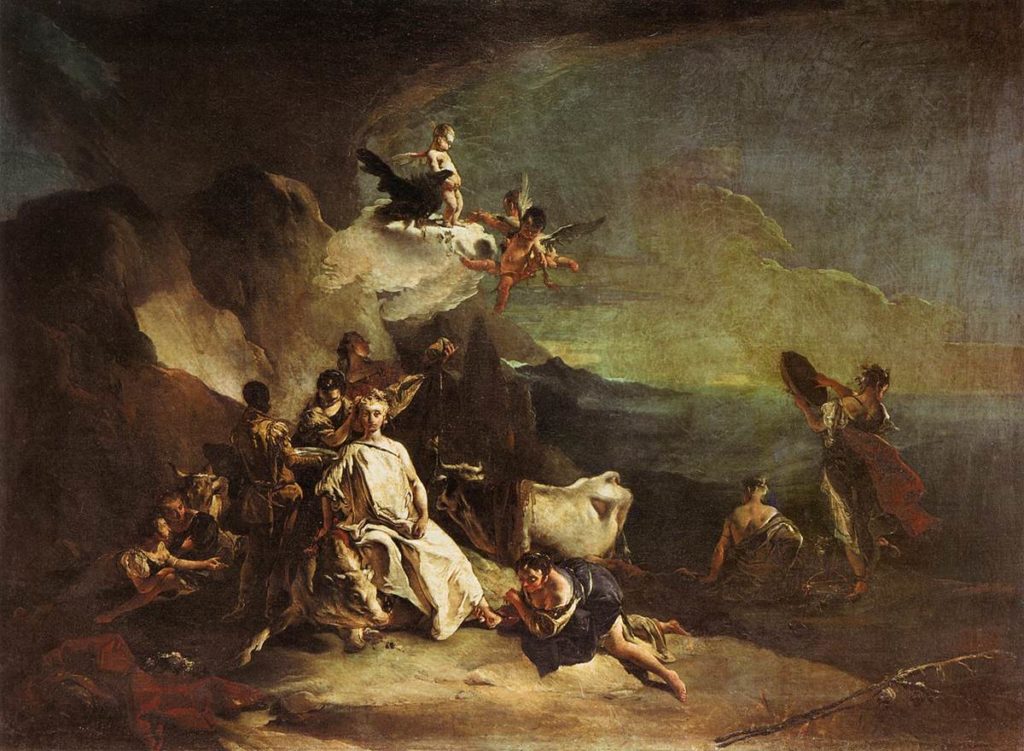
7. Tiepolo, Rape of Europa
Born in 1696 to a prosperous Venice merchant, Giovanni Battista Tiepolo chose to pursue a career in painting. He was considered a “grand master” fresco painter of the Venetian Republic. Tiepolo’s repertoire included literary, historical, mythological, allegorical, and religious works.
The Rape of Europa was inspired by a mythological story from Ovid’s Metamorphoses. Jupiter, king of the gods, is infatuated with Europa. He turns himself into a bull and, in that guise, abducts her.
The painting has a sweeping natural landscape with whimsical mythological episodes. Tiepolo eschews the dark tones of his predecessors, using a slightly lighter palette.
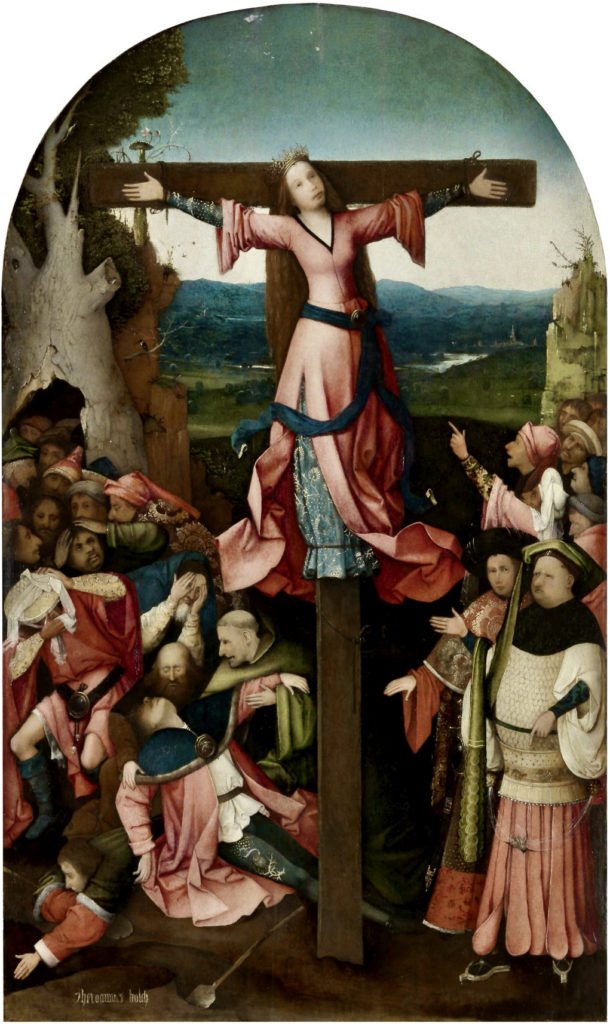
8. Hieronymus Bosch Panels
There are three Bosch paintings in the Accademia, which have all been restored. They are: (1) Hermit Saints Triptych; (2) Vision of the Hereafter; and (3) Saint Liberta Triptych.
Paintings by Bosch are extremely rare. There are only 20 known panels. The 3 in the Accademia are the only Bosch works in any public collection in Italy.
The paintings were owned by Domenico Grimani, a prolific collector and art lover of the time. They were later purchased by the Italian state.
Bosch was nicknamed the “Devil’s Painter.” He filtered biblical stories through his vivid imagination. Bosch’s paintings are full of fantastical creatures, phantasmagorias, and nightmarish scenes.
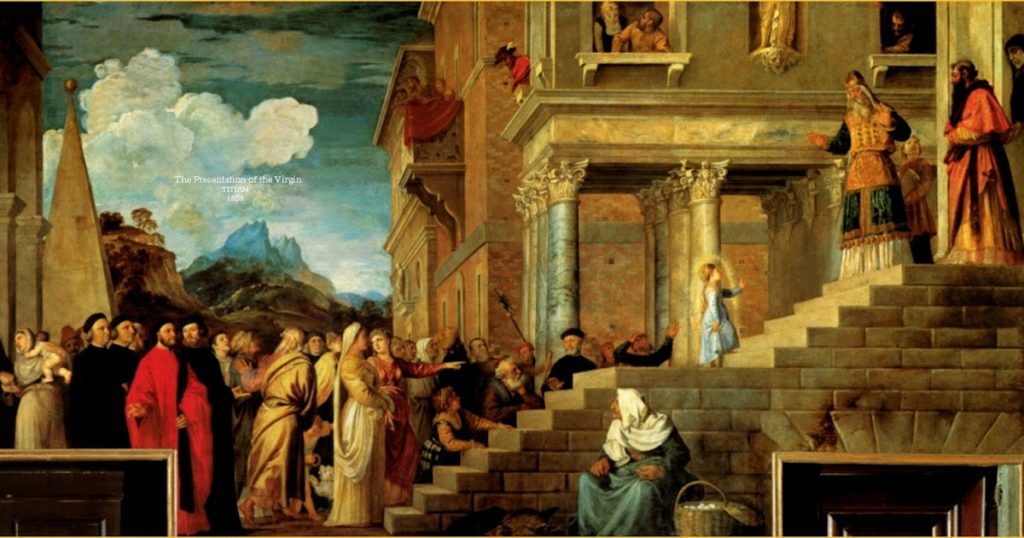
9. Titian, Presentation of the Virgin
This large painting is in the beautiful Sala dell’Albergo, Room 24. Titan painted it just for this room. The subject is the Bible’s Golden Legend.
In the “Golden Legend,” Mary is said to be just three years old when her parents offered her to the Temple. The altar was on a hill with a monumental staircase.
In Titian’s painting of the legend, the vast canvas contrasts with a strikingly diminutive Mary. She confidently walks up the steps. With her right hand, she manages her skirt while her left returns the greeting of the High Priest. Mary is given a full-size aura rather than a halo.
The architecture of the temple is grand, with large Greek columns. This painting was unusual for Titan, who was more of a portraitist. But Titan proves that he is also a master decorator and storyteller.
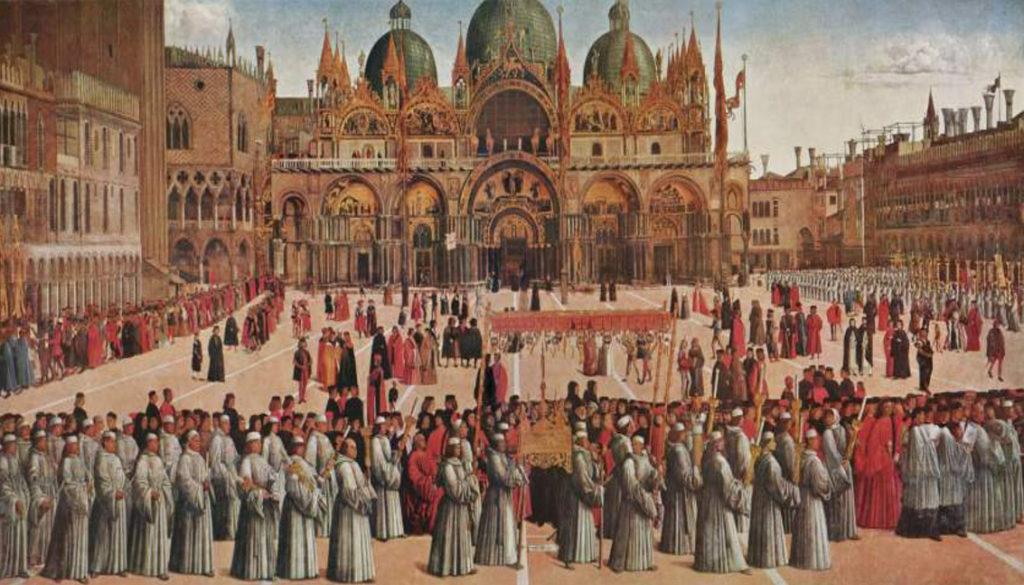
10. Gentile Bellini, The Procession in St. Mark’s Square
This Gentile Bellini painting depicts a healing miracle that took place during the procession of a relic in Venice’s Piazza San Marco. The relic was Venice’s prize possession, a piece of the true cross on which Jesus was crucified.
The painting is a visual documentation of the city of Venice, like so much Venetian art. The painting shows St. Mark’s Square, over 500 years ago and before its 16th century makeover.
In the center front of the painting, there’s a merchant kneeling. Imbued with true belief in the presence of the relic, he prayed for his son to survive a terrible accident. And he did.
Bellini also has another beautiful painting in the museum, the Recovery of the True Cross. This painting brings Venice to life as well. You can see how Venetians used their urban spaces and how they dressed.

11. Vittorio Carpaccio, Healing of the Madman
Carpaccio is best known for his narrative cycles created for the Venetian scuolas. The story in the painting is that a scuola is using its relic to exorcise a demon from a possessed boy. You can barely see it. The scene is in the far left bottom corner.
The topic of the painting is just an excuse for Carpaccio to showcase the city of Venice as a thriving metropolis. Gondolas are everywhere on the bustling Grand Canal. You can see the famous Rialto Bridge. Back then, it was wooden and the only bridge across the Grand Canal.
The painting shows Carpaccio’s mastery of light and color. It’s richly decorative, with Carpaccio’s distinctive tone of red.
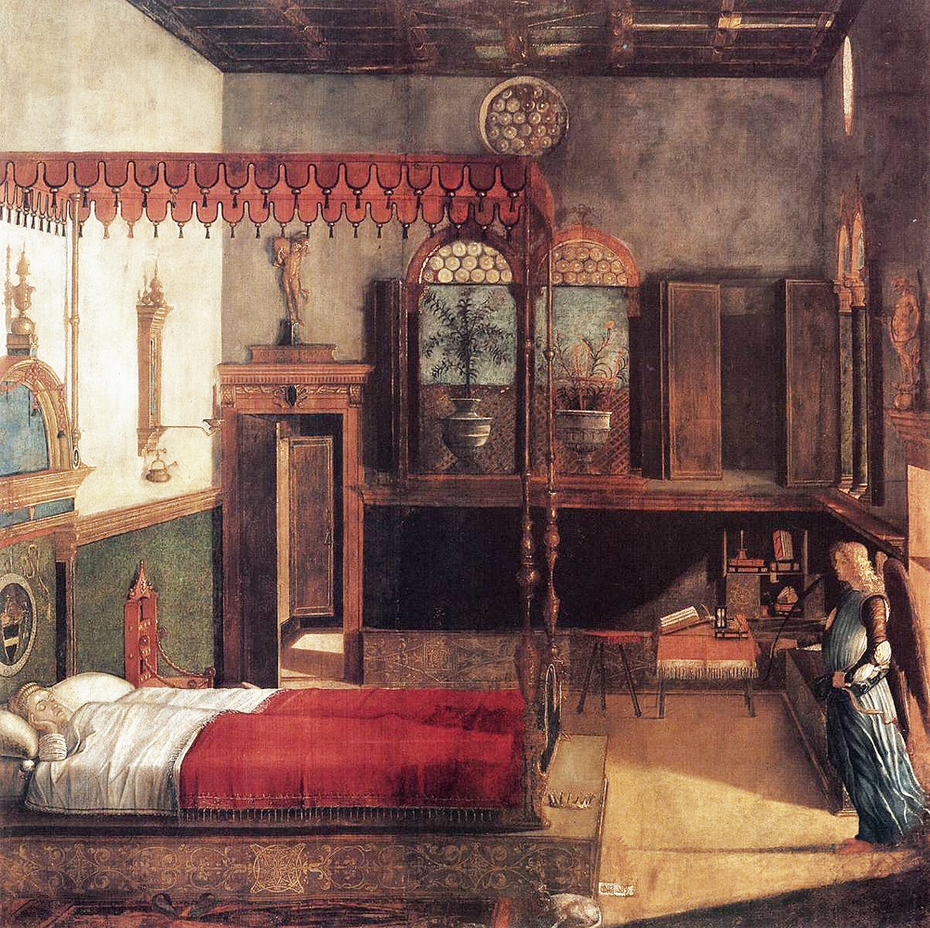
12. Carpaccio, St. Ursula Cycle
The Accademia also has a series of nine large Carpaccio canvases that make up the Saint Ursula cycle. The cycle has its own dedicated room (Room 21), specifically designed for the paintings. They depict the story of Ursula.
She was the daughter of a Christian king who was reluctantly promised in marriage to a pagan prince. The paintings narrate her betrothal, martyrdom, and apotheosis.
The paintings are part reality, part fantasy. You’ll see luxurious interiors and dream-like panoramas of Venice.
The most famous painting in the cycle is the Dream of St. Ursula, shown above. While Ursula sleeps under linen, an angel bathed in light arrives bringing her the palm of martyrdom. The angel’s message? Ursula will die for her faith.
You can see exactly what the interior of a wealthy Venetian would have looked like. Ursula even had books, at a time when they were extremely rare.
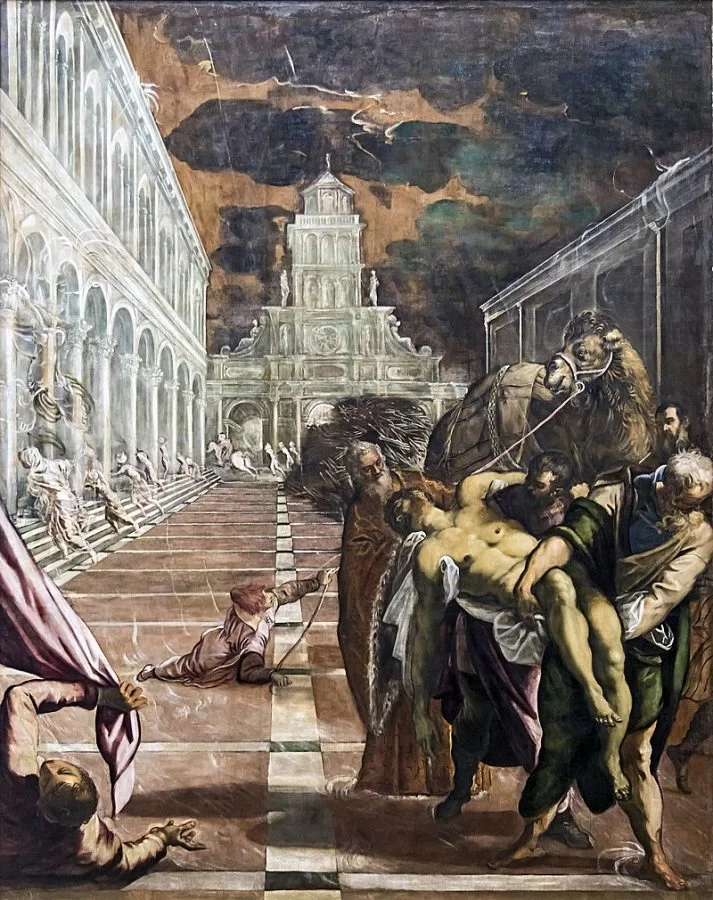
13. Tintoretto, St Mark’s Body Brought to Venice
Did you know that Venice stole the body of St. Mark so that the city had an important relic befitting a major republic? It was one the most outrageous grave robbing in Christian history, a swashbuckling kidnapping by gondola.
In 829, two Venetian merchants stole or “rescued” St. Mark’s body from Alexandria Egypt and smuggled it back to Venice. They concealed his corpse beneath piles of pork products in a gondola, so that muslim officials would steer clear.
Tintoretto painted this picture and others for the Scuola Grande of St. Mark. They depict scenes from the life of St. Mark.
Tintoretto exploded onto the scene in 1548, about 30 years after Giorgione. Tintoretto was a pupil and rival of Titian. But Tintoretto was more avant garde, producing highly dramatic works characteristic of the Mannerist paintings of the late Renaissance.
St. Mark’s Body interprets the historical theft in cinematic fashion. The setting is supposed to be Alexandria. But it looks more like St. Mark’s Square.
There’s a minimalistic background with a haunted sky. The central figures are displaced to the lower right corner, not the center. The painting is dark. Tintoretto used to prime his canvases with black paint.
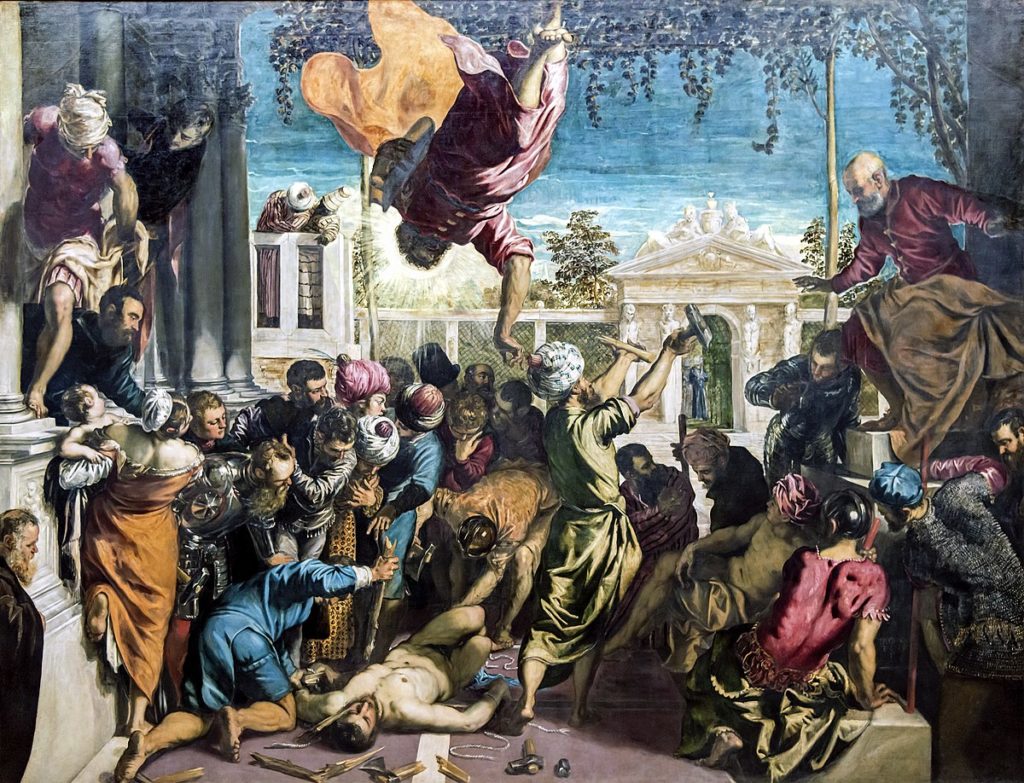
14. Tintoretto, Miracle of the Slave
This Tintoretto painting in his St. Mark cycle depicts one of the saint’s posthumous miracles. The story concerns a slave of a knight in Ancient Rome. When the knight discovered that his slave was Christian, the knight decided to torture and kill the slave. But the slave prayed to St. Mark, who intervened and saved him.
The executioner has dirty feet and a large wooden stake in his hand. The slave is in a dramatically foreshortened position. There’s an enigmatic background, perhaps a Venetian garden. There’s a dramatic and unique use of light and dark.
As I mentioned, Tintoretto was a daring artist. In this painting, his brush strokes are broad and almost impressionist. Art historian Giorgio Vasari accused him of painting with a “broomstick.”
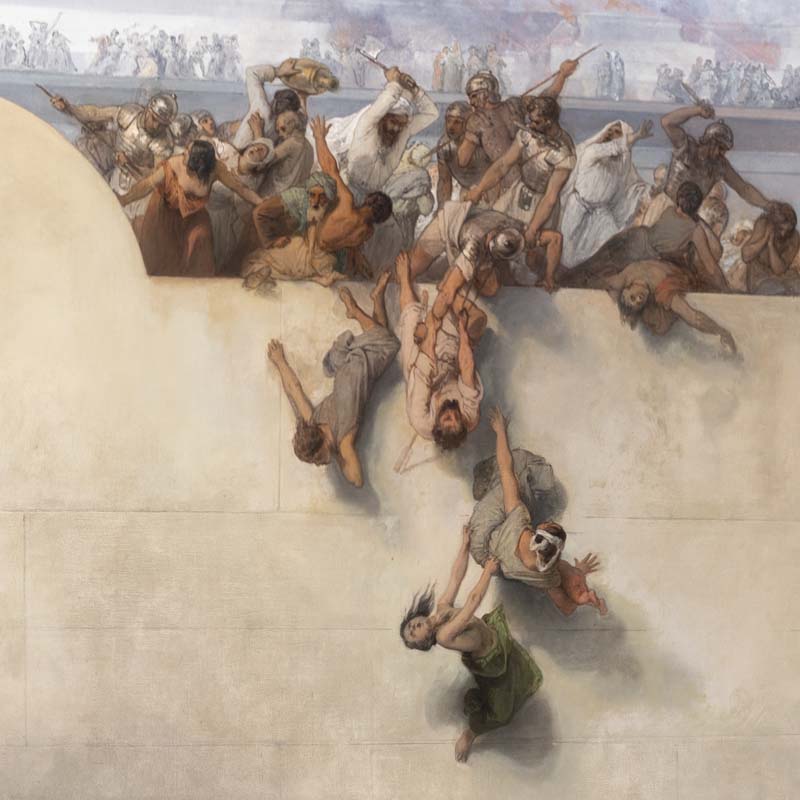
15. Francesco Hayez, Destruction of the Temple in Jerusalem
Francesco Hayez was a Venetian painter working in the 19th century. Hayez was known for his theatrical history paintings and allegories of biblical and classical themes, rendered in romantic style.
The Destruction of the Temple of Jerusalem is a masterpiece from the painter’s late career. It’s a chaotic and violent image of the destruction of Jerusalem by the Roman Emperor Titus in 70 CE.
READ: History of the Roman Emperors
The painting has a visually striking composition. It depicts the destruction of the temple when the carnage is at its height and the building is engulfed in flames. The focal point of the image is the fighting taking place on the giant stone altar.
In 1867, the painting was exhibited in the Brera Museum in Milan to critical acclaim.
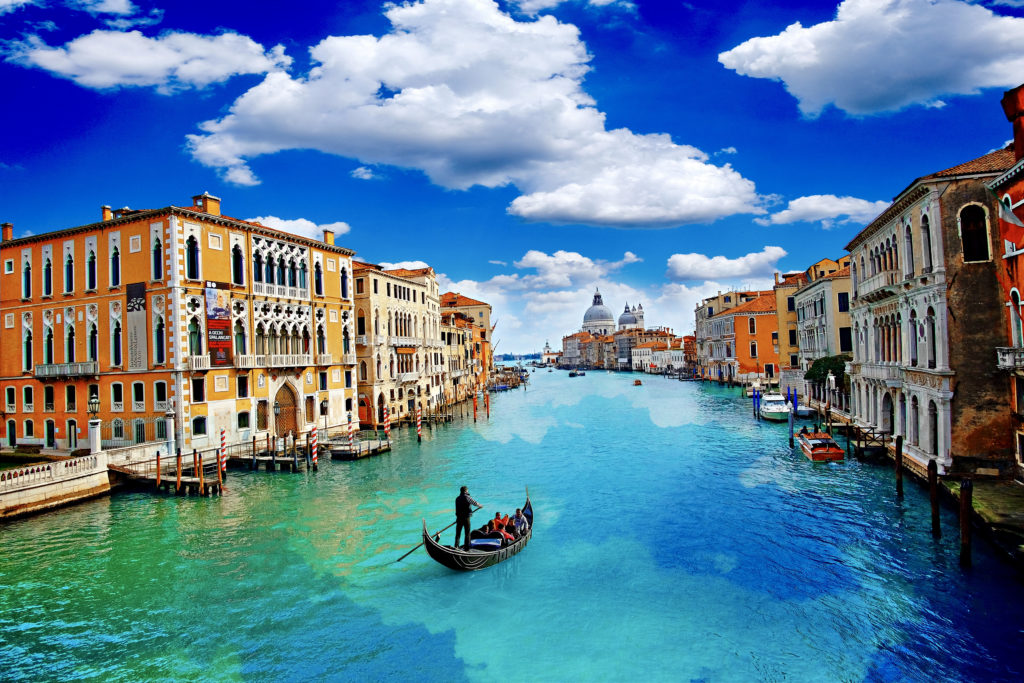
Getting to the Gallerie dell’Accademia
The Gallerie dell’Accademia is in Venice’s picturesque Dorsoduro neighborhood. The museum is located at the foot of the Ponte dell’Accademia and the Grand Canal.
The museum is easily accessible on foot or by Vaporetto. The nearest stations are Accademia and Salute.
Practical Information For Visiting the Accademia Galleria
- Address: Campo della Carità, Dorsoduro 1050
- Hours: Monday 8:15 am to 2:00 pm, Tuesday through Sunday 8:15 am to 7:15 pm
- Entry fee: 12 € with a 1.50 euro booking fee. Click here to pre-book a ticket.
- Website
I hope you’ve enjoyed my guide to the Galleria dell’Accademia in Venice. You may enjoy these other Venice guides:
- 1 day itinerary for Venice
- 2 day itinerary for Venice
- Must see attractions along the Grand Canal
- History of Venice in a nutshell
- Guide to the Peggy Guggenheim Museum
- Guide to the Scrovegni Chapel
- 7 day itinerary Venice to Milan
- Guide to the mosaics of Ravenna
- 10 day itinerary for Italy’s major cities
If you’d like to visit the Galleria dell’Accademia in Venice, pin it for later.

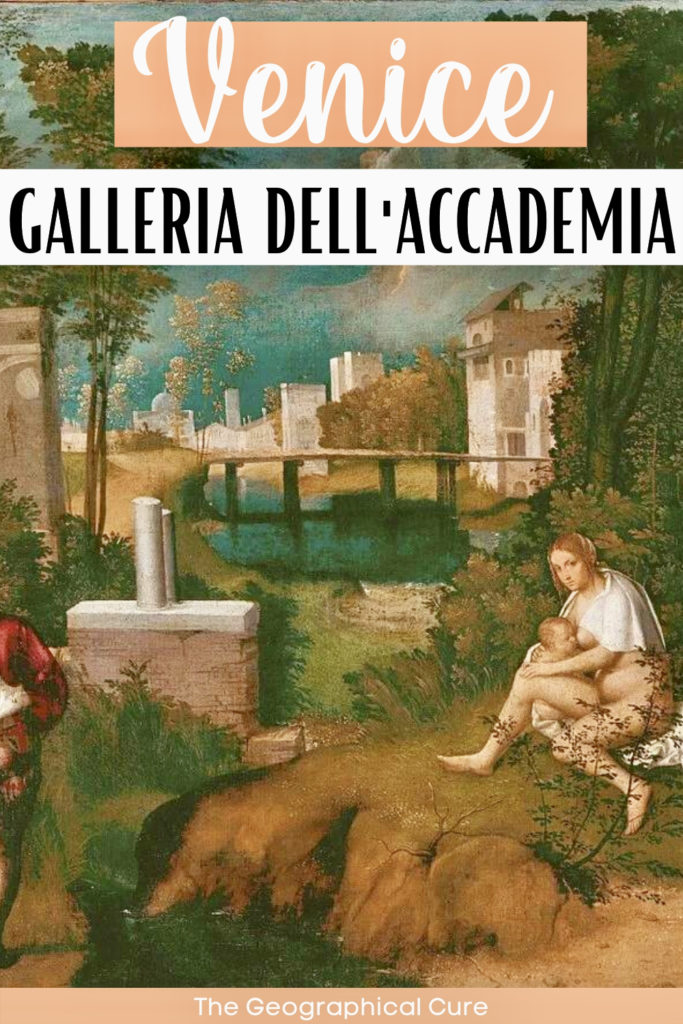
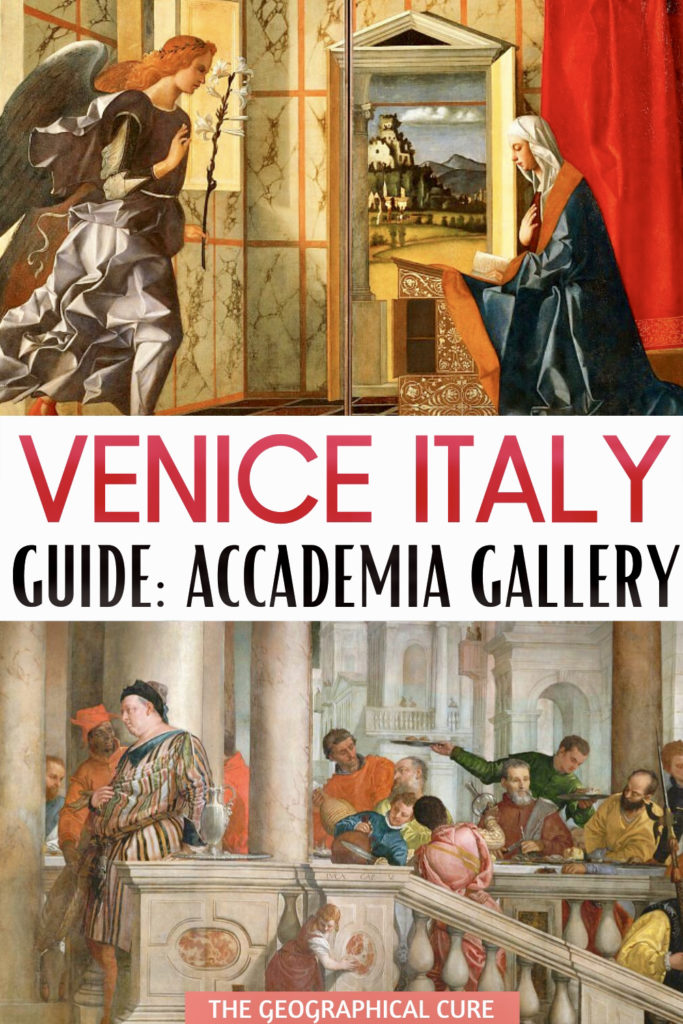
Thank you very much for this excellent, concise introduction to the Academia. We will be there in a few weeks and this guide will certainly enhance our visit. Bravo!
Enjoy! It’s such an underrated museum considering its collection.
You must change the copy on the Pieta piece! Mary Magdalene was NOT the Mary in the painting, it is Christ’s mother, Mary. Two different Marys. Did enjoy your collection, though. Thanks.
Duh, that’s one of my dumber typos. Thanks for pointing it out Pam!
The Bellini Altarpiece is not correct. The picture is the one you can see in San Zaccaria Church.
Thanks Silvia!